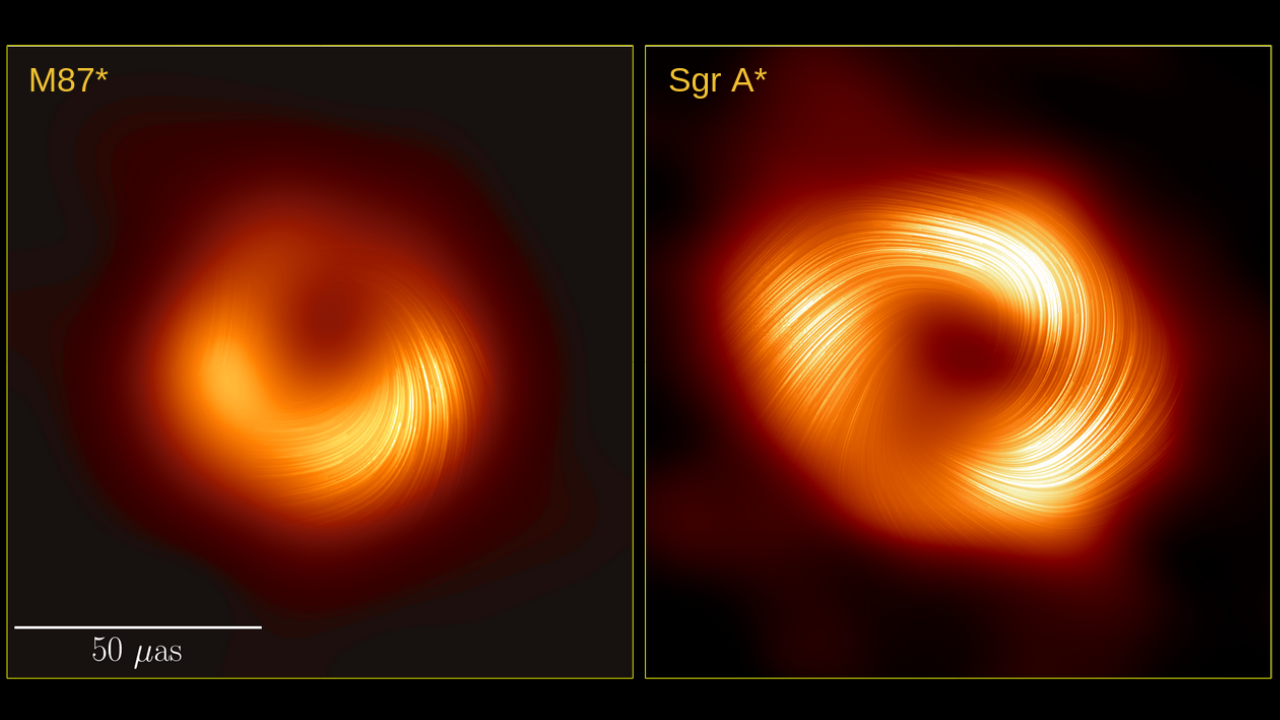The Event Horizon Telescope (EHT) collaboration has unveiled a groundbreaking new image of Sagittarius A* (Sgr A*).
This image isn’t a mere astronomical snapshot; it’s a portal into the extreme environment surrounding the black hole, revealing the swirling tendrils of its powerful magnetic field. The supermassive black hole residing at the very heart of our Milky Way galaxy.
Striking Similarities and the Hurdles of Capturing a Galactic Behemoth

The image itself is a revelation. It showcases a remarkable similarity between Sgr A* and M87*, a much larger black hole previously imaged by EHT. Both objects exhibit a ring-like structure and evidence of intense magnetic fields. This observation suggests that these features might be a universal characteristic shared by supermassive black holes across the vast cosmic expanse.
However, capturing this image of Sgr A* presented a unique challenge compared to M87*. Unlike its larger counterpart, Sgr A* exhibits rapid fluctuations on timescales of minutes. Imagine trying to take a clear picture of a hummingbird in mid-flight – the constant motion blurs the details. This rapid change creates a similar “blurring” effect in the data, making it difficult to discern the black hole’s finer details. To overcome this hurdle, the 2022 image of Sgr A* represented an average of multiple observations, requiring the development of sophisticated image processing techniques that could account for the dynamic nature of the black hole.
A Peek Beyond the Event Horizon: Unveiling Jets and Particle Acceleration
The EHT image offers more than just a confirmation of Sgr A*’s existence. It also provides a tantalizing glimpse into the unseen. The data hints at the presence of a potential jet emanating from the black hole, similar to the powerful jet observed near M87*.
If confirmed, this jet could hold the key to understanding how Sgr A* accelerates high-energy particles like neutrinos and cosmic rays to such incredible speeds. These enigmatic particles, constantly bombarding Earth from all directions, are cosmic messengers carrying information about the most violent and energetic events in the universe. Understanding how they’re accelerated could revolutionize our understanding of these phenomena.

Delving Deeper: The Promise of High-Resolution “Movies”
The EHT collaboration isn’t resting on its laurels. They plan to resume observations of Sgr A* next month. This continued research, coupled with the potential addition of new telescopes to the EHT network, could lead to the creation of high-resolution “movies” of the black hole. Imagine a series of images captured in rapid succession, effectively creating a video of the black hole’s activity. These moving images would provide an unprecedented view of Sgr A*’s dynamics, allowing scientists to study its behavior in much greater detail. Observing the variations in the magnetic field and potential jet activity over time could provide crucial insights into how Sgr A* interacts with its surrounding environment and how it shapes the evolution of our galaxy.
A Testament to Collaboration and Pushing the Boundaries of Knowledge
In conclusion, the new EHT image of Sgr A* represents a significant leap forward in our understanding of these enigmatic objects. It not only sheds light on the magnetic fields surrounding the black hole but also offers intriguing hints about the unseen processes taking place at its heart. As EHT observations continue, we can expect even more groundbreaking discoveries that will reshape our understanding of black holes and their role in the universe. The image is a testament to the power of international collaboration and technological innovation, pushing the boundaries of human knowledge and allowing us to peer deeper into the mysteries of the cosmos.
This image is a captivating reminder that even the most massive objects in the universe can exhibit a surprising degree of dynamism. The swirling magnetic field lines paint a picture of a chaotic and energetic environment, hinting at the incredible forces at play around the event horizon. As we delve deeper into the secrets of Sgr A*, we may unlock new insights into the formation and evolution of galaxies, the nature of gravity, and the very fabric of spacetime itself. The journey to understanding these galactic behemoths has just begun, and the EHT collaboration is at the forefront of this exciting quest.



















